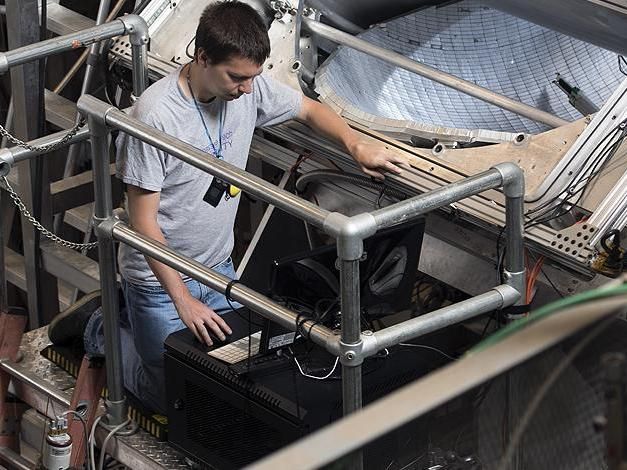What is the origin of the visible mass of the universe?
Supercomputer calculates the mass of the nucleon
An international team of scientists has for the first time computed the masses of one of the most important constituents of matter - protons and neutrons. The tool which contributed the most to this calculation: JUGENE, a supercomputer at the Jülich research cerntre in Germany. The elaborate simulations confirm a fundamental theory of physics, quantum chromodynamics. The team has reported their findings in Science.
“More than 99.9 % of the mass of the visible universe comes from protons and Neutrons”, says Zoltan Fodor, a Hungarian physicist, affiliated with Wuppertal University, who was the leader of the project. These particles, commonly referred to as "nucleons" by physicists, are made of three quarks.
The masses of these three quarks, however, only add up to a few percent of the total mass of a nucleon - so where does the mass of the nucleons come from? The answer is provided by Einsteins famous formula E=mc2: energy and mass are equivalent and more than 95 % of the nucleon mass originates from the motion energy of quarks and particles they exchange.
The three quarks inside a nucleon are bound together by the so-called strong interaction, a force that - as the name suggests - is very strong but only relevant at tiny distances. For quite some time, physicists have been using a theoretical description of this interaction, quantum chromodynamics. “In principle it should be possible to calculate the mass of the nucleons from quantum chromodynamics”, says Fodor.
These calculations are extremely complicated. Similarly to the electromagnetic interaction, which is transmitted by photons, the strong interaction is transmitted by gluons. However, contrary to photons, the gluons interact with each other. This self-interaction is responsible for the fact that the interaction is so strong that quarks do not appear alone, but only as bound states of two or three quarks. This self-interaction makes the theoretical determination of the nucleon mass so complex, that so far it seemed to be beyond our possibilities to carry out this calculation.
Thanks to the JUGENE supercomputer at Forschungszentrum Juelich Fodor and his colleagues were able to solve the problem, and for the first time the managed to treat the strong interaction for larger distances. They calculated the masses protons, neutrons and several other particles, which are bound states of quarks. The calculation of Fodor and his colleagues uses a four-dimensional lattice and the solve the equations of quantum chromodynamics on the sites of this lattice. After that they reduce the distance between the lattice sites in several steps, which brings the result closer and closer to reality, to our continuous space-time. “This is one of the most CPU-demanding calculation known to mankind”, says Fodor.
As a result the researchers obtained the mass of the nucleon, in complete agreement with the experimentally measured value. “This result indicates that quantum chromodynamics is the proper theory of the strong interaction”, concludes Fodor.
The researcher futrther explains, that “the origin of the vast majority of the visible mass is therefore settled”. There are however further riddles yet to be solved. A large fraction of the total mass of the universe is dark and its composition is yet unknown. “We do not know yet what dark matter is and how it gets its mass.”
Other news from the department science

Get the analytics and lab tech industry in your inbox
By submitting this form you agree that LUMITOS AG will send you the newsletter(s) selected above by email. Your data will not be passed on to third parties. Your data will be stored and processed in accordance with our data protection regulations. LUMITOS may contact you by email for the purpose of advertising or market and opinion surveys. You can revoke your consent at any time without giving reasons to LUMITOS AG, Ernst-Augustin-Str. 2, 12489 Berlin, Germany or by e-mail at revoke@lumitos.com with effect for the future. In addition, each email contains a link to unsubscribe from the corresponding newsletter.
Most read news
More news from our other portals
Last viewed contents
Phenomenex: Zebron GC Columns Receive Two R&D 100 Awards
NanoSight is recognised as an ISO9001 Certified Company
Genomic Standards for the Future: Setting the Guidelines - Using the new MIGS standard genomic and environmental data fields can be attributed to the different organisms
New syphilis test provides quicker and easier diagnosis
Establishing standard definitions for genome sequences


























































